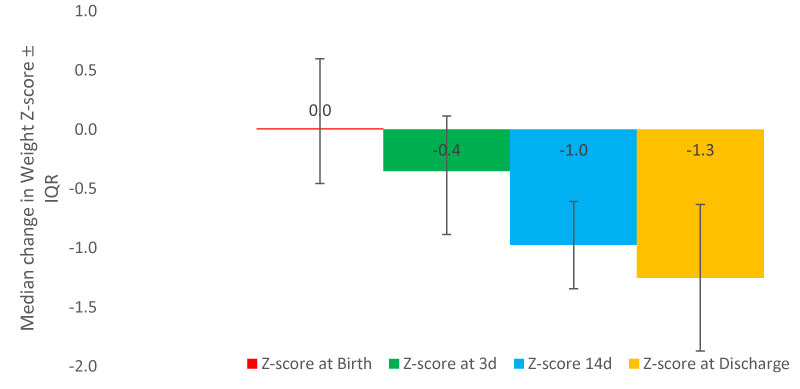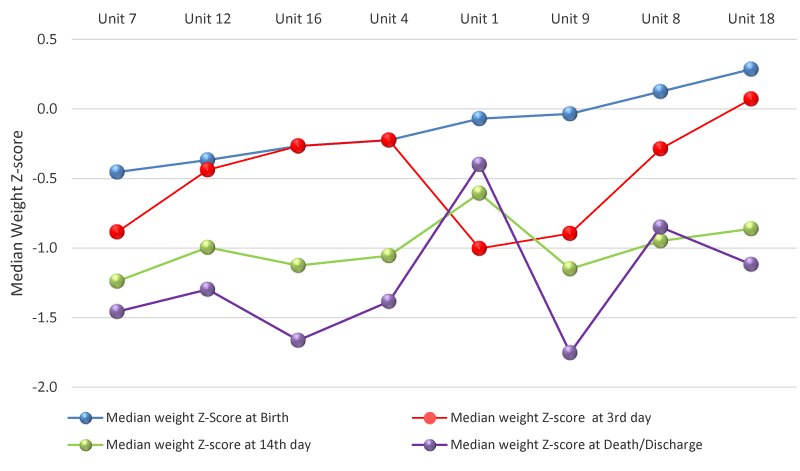When do our Extremely Low Birth Weight (ELBW) Infants Lose their Postnatal Weight??
Angela B Hoyos1*, Marco Belzu Rodriguez2, Maria I Martinini3, Veronica Delgado4, Edwin Gonzalez5 and Carlos Fajardo6
1Neonatology, Clinica del Country, Bogota, DC, Colombia
2Neonatology, Hospital Materno Infantil de Tigre, San Fernando, Buenos Aires, Argentina
3Neonatology, Nuestra Senora de las Mercedes, San Miguel de Tucuman, Tucuman, Argentina
4Neonatology, Hospital de los Valles, Quito, Ecuador
5Pediatrics, Clinica Somer, Rionegro, Antioquia, Colombia
6Neonatolgy, University of Calgary, Calgary, AB, Canada
*Address for Correspondence: Angela B Hoyos, Neonatology, Clinica del Country, Bogota, DC, Colombia, ORCID ID: 0000-0002-5403-3268; E-mail: angela.hoyos@clinicadelcountry.com
Submitted: 09 July 2020; Approved: 21 July 2020; Published: 22 July 2020
Citation this article: Hoyos AB, Rodriguez MB, Martinini MI, Delgado V, Gonzalez E, et al. When do our Extremely Low Birth Weight (ELBW) Infants Lose their Postnatal Weight? Int J Nutr Disord Ther. 2020; 3(1): 006-008. https://dx.doi.org/10.37871/ijndt.id17.
Copyright: © 2020 Hoyos AB, et al. This is an open access article distributed under the Creative Commons Attribution License, which permits unrestricted use, distribution, and reproduction in any medium, provided the original work is properly cited
Download Fulltext PDF
Introduction: Although it is a very controversial issue, many of our ELBW infants do not achieve their growth potential, with consequences that may be permanent.
Objectives: We wanted to investigate when weight was lost or not gained during the postnatal hospitalization in ELBW babies ≤ 28 w GA at birth in the neonatal Epic Latino network, and what was the magnitude of that loss using weight Z score to quantify it, as a surrogate for the expected gain according to Fenton 2013 growth curves.
Design: We reviewed our database for preterm infants ≤ 28 w GA 2018-2019 with data at birth, 3 days, 14 days and at discharge or death and calculated Postmenstrual Age (PMA) and weight Z-score for each data point using the Fenton 2013 curves. We obtained weight Z score median for each mentioned data point of each of the 13 units in our Epic Latino database that had weight information for comparison between units more than 5 cases, in at least the first three post-natal ages. We compared these medians to see if they showed significant differences and run a linear logistic model.
Results: 132 ELBW infants had weight data in at least birth, days 3 and 14. Statistically significant difference was found between the weight Z score median at birth compared to 3rd day, 14 day and discharge/death. There was also a significant difference between weight Z score in the 8 units selected.
Discussion: The average fall on weight Z score on 3rd day of life was expected, it is a physiological change that occurs after birth, however, the continuous fall on day 14 and discharge/death in some units has no explanation and seems a show an insufficient nutrients input. More studies are needed to confirm and devise a way to improve these results.
Introduction
Epic Latino is a neonatal database from Latin America based in the Canadian Neonatal Network collection software and an organization dedicated to quality improvement programs in health practices in neonatal units. One of the quality improvement programs is nutrition. There is a large variability of nutritional practices in neonatal units with the expected variability in nutritional results [1-4].
Although it is a very controversial issue, many of our ELBW infants do not achieve their growth potential, with consequences that may be permanent [5]. Often it is believed that the initial weight loss due to fluid redistribution, [6] is the only important one, however, with some frequency, they continue to grow poorly, even until late postmenstrual ages. There are several stages of possible nutrition failure that can lead to poor growth. These stages include the first week of life, which for fear of metabolic risks, often limits the amount of nutrition required to grow properly [1]. A second moment is when you switch from parenteral to oral nutrition [7]. To quickly remove venous lines, parenteral nutrition is suspended very quickly, without adequate oral delivery. Using breast milk without fortifiers for long periods of time can cause malnutrition [8]. As a third stage in which weight gain is inadequate is during oral nutrition with a limit on the amount of volume generally 150-180 mL/K [9] which is sometimes not enough for proper growth. Some studies with higher volumes have shown better weight gain, [10-13] without having been adapted in many centers. Last, fortifies use can modify growth extensively [12,14-16].
Objectives
We wanted to investigate when weight was lost or not gained during the postnatal hospitalization in ELBW babies ≤ 28 w GA at birth in the Neonatal Epic Latino network, and what was the magnitude of that loss using weight Z score to quantify it, as a surrogate for the expected gain according to Fenton´s growth curves [17].
Design
We reviewed our database for preterm infants ≤ 28w GA 2018 and 2019 that had weight data at birth, 3 days, 14 days and at discharge or death and calculated Postmenstrual Age (PMA) for each data point (which are collected in our network). We obtained a weight Z score calculation for each weight data using the Fenton 2013 curves. We obtained weight Z score medians and Interquartile Range (IQR) from each data point, in these four post-natal days. We also calculated median for each of the 13 units in our Epic Latino database that had weight information and more than 5 cases for individual comparison. We compared these medians to see if they showed significant differences and run a linear regression model controlling for gestational age.
Results
Results can be seen in (figures 1,2). We found 132 ELBW infants that had weight data in at least birth and days 3 and 14. Statistically significant difference was found between the median of weight Z-score at birth compared to 3rd day, 14 day and discharge/death including linear regression results seen in (Table 1) controlled by gestational age. The results of 8 units linear regression with more than 5 cases is shown in (Table 2).
Discussion
The average fall on weight Z score on day 3 of life was expected, it is a physiological change that occurs after birth as discussed in the introduction, however, the continuous fall on day 14 and discharge/death in most units has no explanation and seems a show an insufficient nutrients input. The irregular distribution of the weight Z score drop in the different NICUs draws attention, and they are statistically different control by GA using Unit 18 as a reference for having the largest median value at birth and the largest drop at discharge/death. The absence of falling on day 3 in two units and the irregularity of the fall in several of the others probably speaks of difference in fluids handling in the first 3 days since the subsequent fall on day 14 is evident. In one of the units, no fall was observed after day 3, while an evident fall was observed in the other NICUs, probably showing differences in nutritional management. More studies are needed to confirm and devise a way to improve these results.
Acknowledgment
I want to thank Epic Latino, its board of directors and the participating units for systematically entering the data to have a reliable database and thus be able to do this type of work.
- Arieh Riskin. Meeting the nutritional needs of premature babies: Their future is in our hands. Br J Hosp Med (Lond). 2017; 78: 690-694. DOI: 10.12968/hmed.2017.78.12.690
- M J Tan, R W Cooke. Improving head growth in very preterm infants--a randomised controlled trial I: neonatal outcomes. Arch Dis Child Fetal Neonatal Ed. 2008; 93: 337-341. DOI: 10.1136/adc.2007.124230
- Richard J Cooke. Improving growth in preterm infants during initial hospital stay: principles into practice. Arch Dis Child Fetal Neonatal Ed. 2016; 101: 366-370. DOI: 10.1136/archdischild-2015-310097
- Alexandre Lapillonne, Ian J Griffin. Feeding preterm infants today for later metabolic and cardiovascular outcomes. J Pediatr. 2013; 162: 7-16. DOI: 10.1016/j.jpeds.2012.11.048
- Bai-Horng Su. Optimizing nutrition in preterm infants. Pediatr Neonatol. 2014; 55: 5-13. DOI: 10.1016/j.pedneo.2013.07.003
- N Modi, P Bétrémieux, J Midgley, G Hartnoll. Postnatal weight loss and contraction of the extracellular compartment is triggered by atrial natriuretic peptide. Early Hum Dev. 2000; 59: 201-208. DOI: 10.1016/s0378-3782(00)00097-9
- Malki Miller, Ruben Vaidya, Deepa Rastogi, Alok Bhutada, Shantanu Rastogi. From parenteral to enteral nutrition: a nutrition-based approach for evaluating postnatal growth failure in preterm infants. JPEN J Parenter Enteral Nutr. 2014; 38: 489-497. DOI: 10.1177/0148607113487926
- Emma L Tonkin, Carmel T Collins, Jacqueline Miller. Protein Intake and Growth in Preterm Infants: A Systematic Review. Glob Pediatr Health. 2014; 1: 2333794X14554698
- Afaq Hussain, Abdur Rehman, Nazia Fatima. Comparison of volume and frequency advancement feeding protocols in very low birth weight neonates. Pak J Med Sci. 2018; 34: 78-81. DOI: 10.12669/pjms.341.14092
- Thangaraj Abiramalatha, Niranjan Thomas, Vijay Gupta, Anand Viswanathan, William McGuire. High versus standard volume enteral feeds to promote growth in preterm or low birth weight infants. Cochrane Database Syst Rev. 2017; 9: CD012413. DOI: 10.1002/14651858.CD012413
- C A Kuschel, N Evans, L Askie, S Bredemeyer, J Nash, J Polverino. A randomized trial of enteral feeding volumes in infants born before 30 weeks' gestation. J Paediatr Child Health. 2000; 36: 581-586. DOI: 10.1046/j.1440-1754.2000.00577.x
- Niranjan Thomas, Anish Cherian, Sridhar Santhanam, Atanu Kumar Jana. A randomized control trial comparing two enteral feeding volumes in very low birth weight babies. J Trop Pediatr. 2012; 58: 55-58. DOI: 10.1093/tropej/fmr011
- Colm P Travers, Timothy Wang, Ariel A Salas, Erin Schofield, Madeline Dills, Deborah Laney, et al. Higher of usual volume feeds in very preterm infants: A randomize control trial. J Pediatr. 2020; S0022-S3476: 30624-30627. DOI: 10.1016/j.jpeds.2020.05.033
- Wesam Alyahya, Judith Simpson, Ada L Garcia, Helen Mactier, Christine A Edwards. Early versus delayed fortification of human milk in preterm infants: A systematic review. Neonatology. 2020; 117: 24-32. DOI: 10.1159/000501279
- Sertac Arslanoglu, Clair Yves Boquien, Caroline King, Delphine Lamireau, Paola Tonetto, Debbie Barnett, et al. Fortification of human milk for preterm infants: Update and recommendations of the European Milk Bank Association (EMBA) working group on human milk fortification. Front Pediatr. 2019; 7: 76. DOI: 10.3389/fped.2019.00076
- Sanket D Shah, Narendra Dereddy, Tamekia L Jones, Ramasubbareddy Dhanireddy, Ajay J Talati. Early versus delayed human milk fortification in very low birth weight infants-a randomized controlled trial. J Pediatr. 2016; 174: 126-131. DOI: 10.1016/j.jpeds.2016.03.056.
- Tanis R Fenton, Jae H Kim. A systematic review and meta-analysis to revise the Fenton growth chart for preterm infants. BMC Pediatr. 2013; 13: 59. DOI: 10.1186/1471-2431-13-59



Sign up for Article Alerts